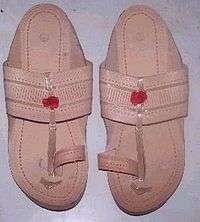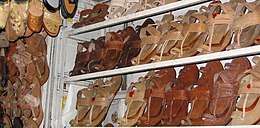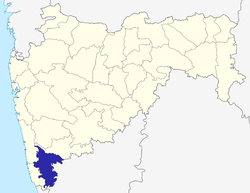Kolhapuri chappal
Kolhapuri chappals are Indian hand-crafted leather slippers that are locally tanned using vegetable dyes. Kolhapuri Chappals or Kolhapuri s as they are commonly referred to are a style of open-toed, T-strap sandal.

In July 2019 Kolhapuri chappals got a geographical indication tag from the Controller General of Patents, Designs & Trade Marks. There is a wrong perception that only artisans from Maharashtra are involved in making these chappals. But many artisans from Karnataka are also involved in making Kolhapuri chappals for centuries. Districts such as Bagalkot, Belagavi, Dharwad and Bijapur district of Karnataka as well as Kolhapur, Sangli, Satara and Solapur districts of Maharashtra will only be able to carry the tag of "Kolhapuri chappal".[1][2] [3]
History
The origin of Kolhapuri Chappals dates back to 12th century when the King Bijjala and his prime minister Basavanna encouraged Kolhapuri Chappal production so as to uplift the cobbler community.[4] According to historic records, Kolhapuris were first worn as early as the 13th century. Previously known as Kapashi, Paytaan, Kachkadi, Bakkalnali, and Pukri, the name indicated the village where they were made.[5]
Origin claims
There is a controversy behind the origin of Kolhapuris. Karnataka leather industry board claims these were originated from Kapsi village in Karnataka. It is said that chappals were made in Kapsi village and were sold in front Mahalakshmi Temple, Kolhapur and that's the reason they have acquired such name and some claim these chappals originated from Kolhapur.[6]
Production process
It can take up to six weeks to make a pair of Kolhapuris.[7] Originally made from buffalo-hide and thread, they weighed as much as 2.01 kilos because of the thickness of the sole, which made them durable despite the extreme heat and mountainous terrain found in the state of Maharashtra.
For making Kolhapuri Chappal various operations are done step by step:-
- Skiving
- Pattern making and cutting
- Attachment of upper and bottom heels.
- Stitching
- Finishing
- Punching and Trimming
- Decoration and Polishing
- Assembling
Design and durability
The designs have moved from the ethnic to ones with more utilitarian value and materials from primal hard materials to softer and more comfortable to wear materials. The artisans themselves designed ethnic patterns and sold, but today the traders and businessmen with demand for cheap products drive the requirement of minimalist designs.
Kolhapuri chappals are known to last a lifetime if maintained well and not used in rainy seasons.

In the seventies, with the Hippie movement Kolhapuri chappals became a very popular footwear in the United States. The success faded out and recently came back influencing now models that are called toe ring sandals.
References
- "Kolhapuris: The famous leather chappal get Geographical Indication tag - Geographical Indication tag". The Economic Times. 19 July 2019. Retrieved 21 July 2019.
- Patil, Abhijeet (21 June 2019). "Kolhapuri chappal gets GI tag after decade-long wait". The Times of India. Retrieved 25 December 2019.
- "Namma Kolhapuri chappal gets GI boost". The New Indian Express. Retrieved 25 December 2019.
- Parihar, Himanshi (25 June 2019). "In Pics: Kolhapuri Chappal Gets GI Tag; What Is It & List Of Indian Items Like Haldi And Shawls That Have It". ED Times | The Youth Blog. Retrieved 25 December 2019.
- "History of Kolhapuri Footwear-Indianmirror".
- "ಸೋಲ್ ಗೆಲುವು". Udayavani - ಉದಯವಾಣಿ. Retrieved 25 December 2019.
- http://www.chappals.co.uk/kolhapuri/
